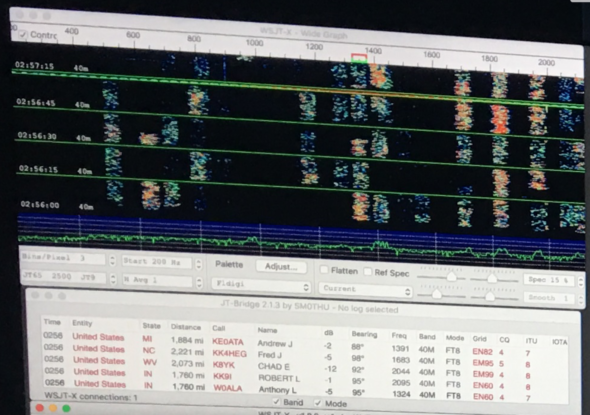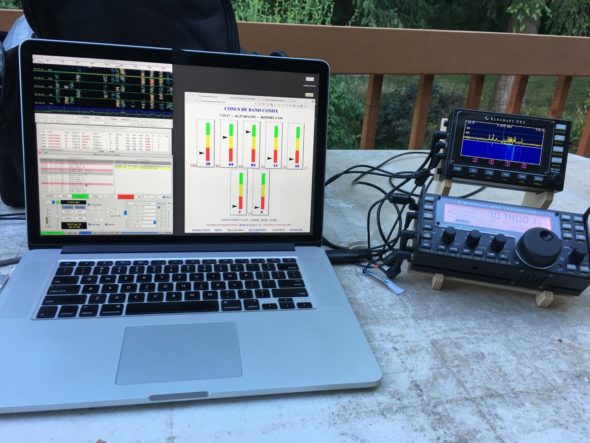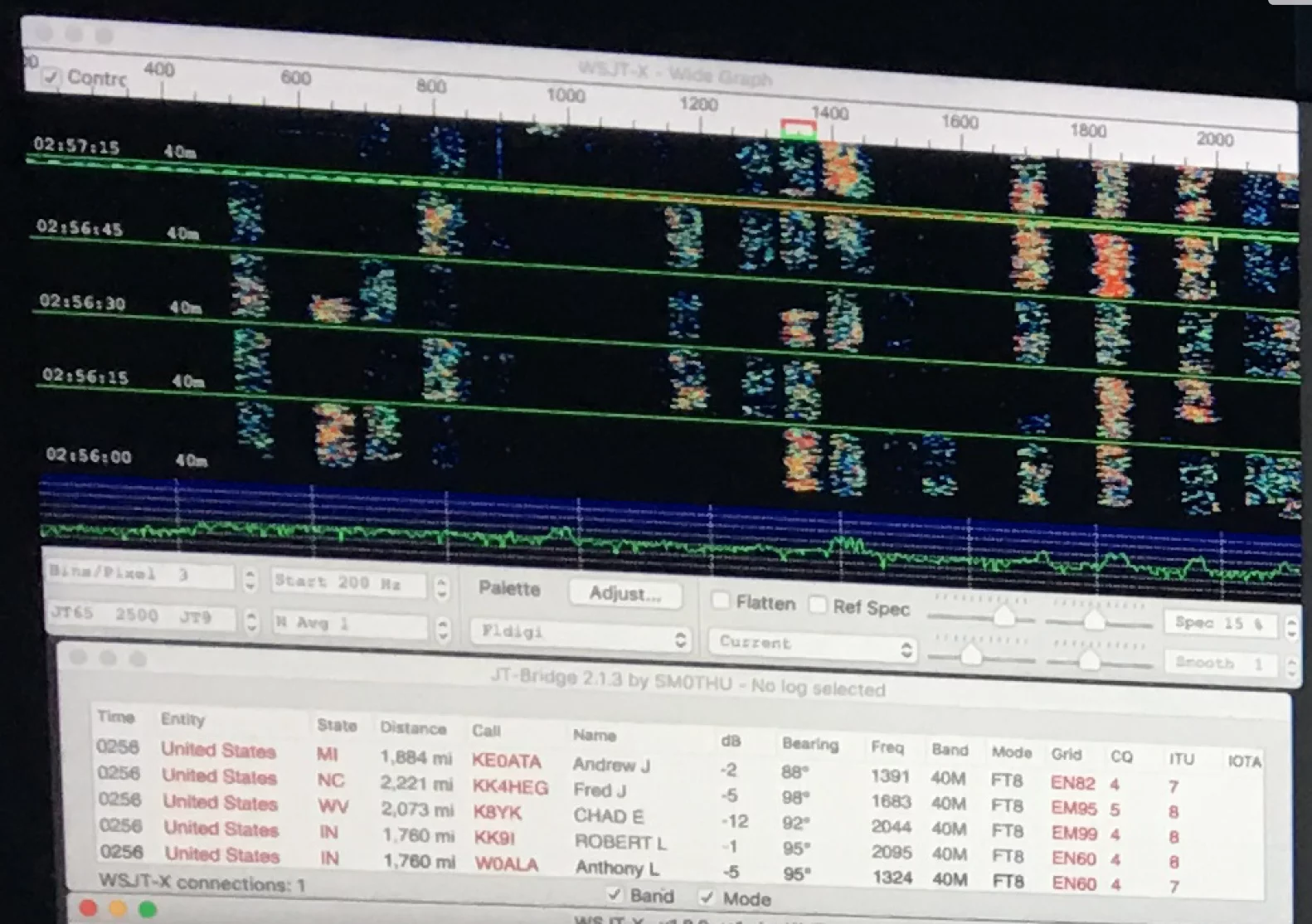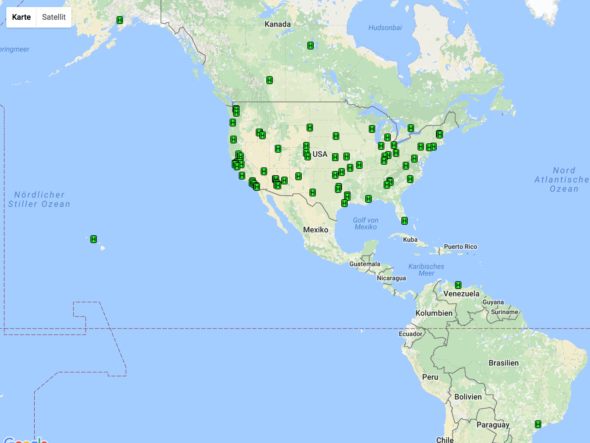(For setting up FT8, go here.)
Setting up WSPR (Weak Signal Propagation Reporting) was done in preparation for playing with the two-way digital communication modes. The set I was initially aiming for is JT9/JT65, named after Joe Taylor, for very short messages that can be received far away, in noisy conditions.
What makes this work are:
- Short messages.
- Long transmission cycles. For most voice communication, you’re rarely talking more than 15 seconds. These modes run a full minute.
- Lower power. Radios aren’t intended to be on all the time. (Same concept for my minivan: it could go 100mph, but running it all the time is probably not a good idea for multiple reasons.) High power * sustained time = more heating.
- Accurate clock. Starting right on the minute makes it easier to decode and be decoded. Most modern computers make use of a time servers, though as I learned, this may be antithetical to power-savings. Apple, for example, lets the clock drift a few seconds here and there. For most purposes, that’s okay, but in these digital modes, it’s waaaaaay too much. I’ve found that I need to update the official time when I power on, and then again about once every hour or two. For example, this morning, the clock was 1.62 seconds off. The horror!
- Accurate frequency. My radio has a special temperature compensation procedure whereby you pipe in a known, super-accurate frequency and measure how much the radio drifts as the temperature changes. Once that’s done, the radio will compensate. I have not done this yet.
There’s a newer digital mode called FT8 (Frankie-Taylor) that trades some of the sensitivity for much shorter cycle time of 15 seconds. Since it is still in beta preview, I figured folks would have much higher patience for a complete n00b learning to use his radio at the same time.

Typically, I’ll listen to an area on the spectrum until someone requests a contact (or I can make requests myself if there are gaps). The photo above is the spectrum on the 40M band (7.074MHz) last night. Each column represents an 50Hz slice of someone talking. Brighter/redder patterns are a stronger signals.
Horizontal lines are slices of 15 seconds. The gap between 02:56:45 and 02:57:15 was my transmitting in response to a request from Anthony, in Indiana. (I’ve never been able to get through to him, though.)
A successful sequence may look like this:

Translated, it works out to mean:
| Translation | |
|---|---|
| CQ WA0RVK EM36 | This is Philip from south of Springfield Missouri. Is anyone there? |
| WA0RVK WT8P CN87 | Philip, I’m Jim and I’m east of Bellevue Washington |
| WT8P WA0RVK -16 | Jim, this is Philip, you’re signal to noise ratio is -16* |
| WA0RVK WT8P R-02 | Philip, this is Jim, your signal to noise ratio is -02. |
| WT8P WA0RVK RRR | Jim, this is Philip, acknowledged. |
| WA0RVK WT8P 73 | Have a great day, Philip. — Jim |
| WT8P WA0VRK 73 | You too, Jim. — Philip |
And that’s it. The elapsed time was about a minute and a half (compared to six minutes with JT9/65). *My signal to noise ratio, -16dbm, is pretty faint, on par with a wifi network, but it’s not bad for 2600 kilometers away. When we were having our exchange, our clocks were off by about 0.4 to 0.9 seconds, which happened to work out this time.
Remember what I said about the clocks? In this exchange, our clocks differed between 0.4 and 0.9 seconds. The transmit cycle is 15 seconds, which is 12.6 seconds of actual transmitting, about a second to decode the pattern into a 13-character message (72 bits!), do an internet lookup of the person, display the results; and 1.4 seconds for me to respond.
Initiating these contacts is very much manual and, as much as this activity could be, a small adrenaline rush of “Did I click in time? Will I be able to reach this person with my tiny radio? Will they respond?”
If the clocks are off 0.9 seconds, then there would normally be scant time to respond. Moreover, doing this six times a row is hard. The WSJTX software includes some automation to send standardized messages once we’ve established communication. Thus, starting at the end of the third message, when he responds back to me with a signal report, the computer will handle the remaining messages. If I don’t receive an acknowledgement — someone’s already beat me to it, he’s given up, or he’s trying again — my computer will repeat.
Over the last two weeks, I’ve exchanged contacts with several states, Canada, Brazil and Venezuela (who happened to also be my first contact!).


